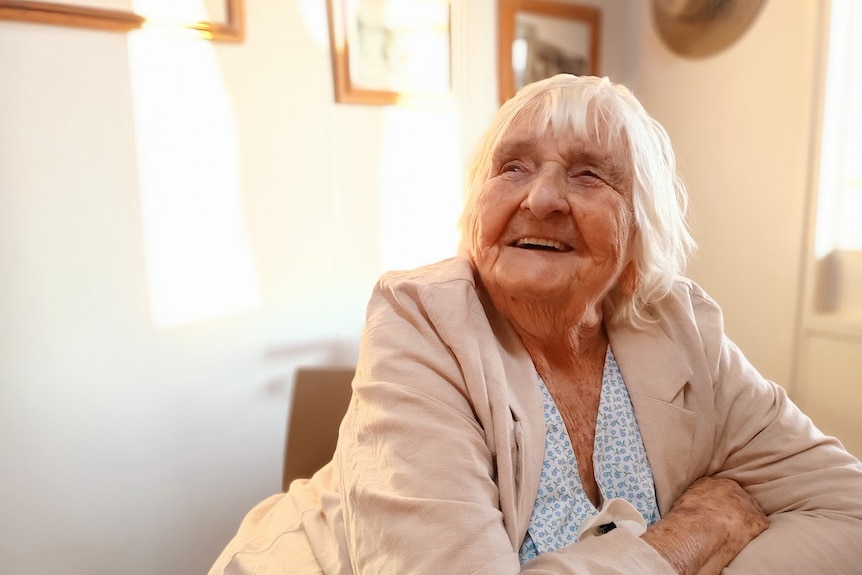The Cooper Creek in South Australia’s far north-east is in full flow toward Lake Eyre as four sisters meet on its banks where the youngest was born nearly 90 years ago, during the Great Depression.
Aboriginal and Torres Strait Islander readers are advised that this article contains images and names of people who have died.
Olive, Nora, Ethel and Isabella have come to reflect on the life and legacy of their mother, Ettie Darlington. Against the odds, she raised her six children alone after losing her partner in the outback.
“The creek was racing down there,” Ethel said.
“That’s where we were camped for 15 months — under a tarpaulin.”
At the age of 19, Ettie left her family home in Wowan near Rockhampton, after meeting a drover named John Hill.
For the next 15 years, the two ventured on foot across central and western Queensland for work as their family grew.
The four surviving children have now set out to retrace their family journey.
“We wanted to see where mum walked to,” Olive said.
“She walked from Bundaberg all the way out here to Innamincka … and had all of us along the way.”
The siblings were each born in different places, including Charleville, Blackall, Mackay, Ilfracombe, Boulia and Cooper Creek.
“It was an adventure and all of us can remember different things about all these different places,” Olive said.
Saved by Indigenous generosity
The family trek ended roughly 24 kilometres west of Innamincka by the Cooper Creek.
Eventually, John left the family to seek assistance, ultimately vanishing into the endless expanse of Australia’s interior, never to be seen again.
Ettie, pregnant with her sixth child, was left to care for her children alone in the outback.
“Mum had Aboriginal friends that helped with food and milk and that is exactly how we survived,” Ethel said.
“They showed great generosity and were so helpful to us.”
Yvonne Darlington is Ettie’s niece and has researched the family’s history for a book.
She explained how a young Yandruwandha woman named Molly, aged about 20, supported Ettie and her children.
“They had help from the white community later but … if it wasn’t for Molly and her friends, they would have died,” Yvonne said.
“They brought them fish and food and basically kept them alive.”
The police distributed some government rations to the family.
“What they were getting from the local copper was flour, tea and sugar,” Yvonne said.
“He put them on the same rations they used to give the old and infirm Aboriginal people, and he put Ettie on that list.
“But in terms of actual food and protein, that was all coming from the Aboriginal community.”
Born by the bank
The four sisters believe Molly helped their mother give birth to Isabella by the Cooper Creek while the eldest son Norman ran to Innamincka for help.
“Molly was the one who was core to Ettie’s experience out there, which is why I put in the effort to find out more about her,” Yvonne said.
“It was very important to the family.”
In her research, Yvonne discovered that Molly’s own family’s story didn’t end well.
“Sadly she died at the age of 36 in childbirth on a station in south-west Queensland,” Yvonne said.
“Her children were all taken to Woorabinda Aboriginal Mission.”
Yvonne’s research has put Ettie’s surviving children in touch with Molly’s community.
“We’ve been in contact with them since we’ve come out here, the descendants of Molly who helped Mum,” Isabella said.
“The links have lasted all this time.”
‘They tried to separate us’
Olive recalled that events moved quickly for the family after Isabella was born.
“Our brother ran up to the hospital to get the doctor to come down and bring Mum up there,” she said.
“When Mum had Isabella, she had malnutrition and had to be flown to Brisbane.
“I saw the aeroplane that took Isabella away because it was too far to drive the baby there.”
A Boulia-based clergyman of the Australian Inland Mission named Cliff Lanham lobbied the Queensland government to have Ettie and her children relocated to an urban environment.
He drove the children to Brisbane where they fought to remain as a family unit.
“They tried to separate us,” Olive said.
“They wanted to put us in different homes and Mum wouldn’t allow it.
“We all wanted to stay together and she kept us all together.
“She got a little bit of help from the government but she kept us all together on her own.”
A tight-knit family
Isabella said it was a special experience to follow her mother’s trail with her sisters to the place where she was born.
“The memories of what her life would have been like … she was a very brave person,” Isabella said.
Ettie lived in the coastal Brisbane suburb of Wynnum until she passed away in 1998.
The sisters said that caring for others was a lesson from their mother that they continued to live by.
“There was a lady who had trouble and Mum took her in and had her six kids living in her house along with all of us,” Isabella said.
“That’d be a dozen different kids, all together.
“That’s how Mum was. She’d take anybody in.”
After nearly nine decades since they were first taken from the banks of Cooper’s Creek, Ettie’s remaining four children show no sign of growing apart.
“We’ve lost a sister and a brother but we all stayed together,” Olive said.
“We argue a lot but we all have fun together, we have a great time.”
On returning to Innamincka during a wet season, the sisters were in agreement: “As a holiday, it’s been wonderful, except for the bloody flies”.
